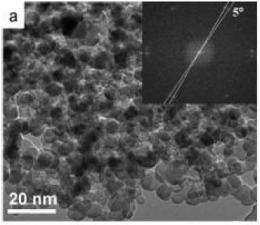July 5, 2011 feature
Graphene quantum dots could lead to low-cost solar cells and OLEDs

(PhysOrg.com) -- Fabricating photovoltaic devices – those that convert sunlight into electricity – out of organic materials has several advantages over using non-organic materials, such as flexibility and good light absorption. However, the widespread commercialization of organic photovoltaic devices remains limited due to the high cost of the electron donor and acceptor materials used in these devices. In a new study, scientists have addressed this issue by fabricating luminescent graphene quantum dots (GQDs) blended with organic polymers for use as electron acceptors, which could offer better performance at lower cost than other polymer-based organic materials.
The researchers, Dr. Vinay Gupta and coauthors from the Organic and Hybrid Solar Cell Group at the National Physical Laboratory in New Delhi, India, have published their study in a recent issue of the Journal of the American Chemical Society.
As the scientists explained, many previous studies have been investigating the use of quantum dots as electron acceptor materials in photovoltaics. Quantum dots have beneficial properties – such as their size-tuned optical response, efficient multiple carrier generation, and low cost – that make them attractive for photovoltaic devices. However, most quantum dots that have previously been studied are composed of toxic metals, such as cadmium and lead, which would pose serious problems for large-scale device applications.
In contrast, the 9-nm quantum dots made of graphene that the scientists have fabricated here do not have the same hazardous nature, yet they have similar electronic properties. Most importantly, graphene has a high charge carrier mobility, which means that it can quickly transport charges to the electrodes, reducing current losses and improving solar cell efficiency. In their experiments, the researchers found that GQDs blended with a conjugated polymer exhibit significantly enhanced characteristics compared to graphene sheets blended with the same polymer.
“This work shows that graphene quantum dots can be a good acceptor and can replace expensive C60-based acceptors,” Gupta told PhysOrg.com. “This work has implications for inexpensive and efficient solar cells as well as organic light-emitting diodes (OLEDs). The potential advantages are light weight, flexible, cost-effective, roll to roll manufacturing, large area processing and multi-purpose use.”
The scientists fabricated both photovoltaic solar cells and OLEDs out of the new GQD-based material, demonstrating an overall good performance in both devices. The results show that the material can be environmentally friendly and more stable than current organic materials. The researchers also predict that the performance of these devices could be further improved, and plan to experiment with using other polymers.
“At present the efficiency is low, so we are working towards increasing efficiency of the GQD-based solar cells,” Gupta said.
More information: Vinay Gupta, et al. “Luminescent Graphene Quantum Dots for Organic Photovoltaic Devices.” Journal of the American Chemical Society.” DOI: 10.1021/ja2036749
Copyright 2011 PhysOrg.com.
All rights reserved. This material may not be published, broadcast, rewritten or redistributed in whole or part without the express written permission of PhysOrg.com.

















